It wasn’t the government that made cars safer to drive. It was the free market that made them less likely to crash.
Which made them safer to drive. As opposed to “safer” to crash. The latter is what we get from government, which has also made cars more likely to crash by – among other things – making them harder to see out of, which resulted from the car companies being obliged to make them safer to be inside of when you crashed them. More metal – less glass. The doors held up better to impact forces such as the car coming at you from the side you didn’t see and pulled out in front of.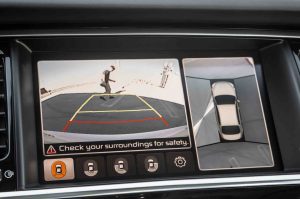
Government fixed the blind spots its “safety” mandates caused by mandating blind spot alert systems and rearview camera systems, to help drivers avoid backing up over kids and others they couldn’t see behind them anymore, due to the government’s crashworthiness requirements.
But it wasn’t the government that mandated radial tires, to cite one example of a design improvement that made cars safer to drive by making them handle and brake better. Radial tires also improve the vehicle’s fuel economy and they last longer, which conserves both natural resources and people’s resources (i.e., their money, which they spend less of). The government had nothing to do with getting radial tires into circulation. It was car manufacturers such as Pontiac, which was one of the first to offer not just radial tires as factory-installed equipment but also a Radial Tuned Suspension (RTS) system designed around radial tires.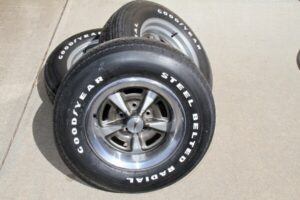
This was in the early 1970s.
By the late 1970s, radials had become the type of tires almost every car came with from the factory.
While we’re talking Pontiac – which is proper because it was Pontiac that was one of the brands that made cars that handled much better and so were much less likely to go out of control and crash, which made them safer to drive – a mention ought to be made of the anti-away bars front and rear that were part of the RTS suspension package Pontiac offered back in the ’70s. Adding the rear bar in particular greatly evened out the handling dynamics of a car so equipped by correcting for excessive oversteer, which (without the rear bar) could – and often did – result in loss of control during cornering and sudden accident-avoidance maneuvering.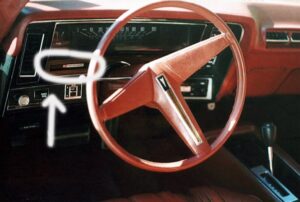
The government had nothing to do with this.
And yet, anti-sway bars (front and rear) quickly became as ubiquitous as the air bags government insisted everyone buy – and never mind the fact that the car industry had developed and offered air bags as optional equipment for those who wanted them some 20 years before everyone else was essentially forced to buy them, if they wanted to buy a new car.
Probably because this kind of safety sells – and so doesn’t require government mandates.
How about front disc and then four wheel disc brakes? The government mandated neither, either – yet both greatly improved controllability during braking and also greatly reduced braking distances vs. the drum brakes (on all four wheels) that were common before several manufacturers began offering front disc brakes back in the late ’60s – and then four-wheel-disc brakes in the ’70s. One such was Cadillac, which made four wheel disc brakes standard equipment in the Seville back in 1977. By 1978, Pontiac was offering four wheel disc brakes as an option for the Firebird.
Today, almost every car (and truck and SUV) comes standard with four wheel disc brakes – and the government had nothing to do with it. 
Interestingly, traffic fatalities declined greatly in tandem with the advent of and then ubiquity of radial tires, well-designed suspension systems and disc brakes – because the average car had become much more controllable, especially during sudden/abrupt and unanticipated maneuvering such as swerving or panic braking to avoid a child that ran in front of the car.
But then cars became more likely to hit something again – as government got involved in making them “safer.” Now they all have “advanced safety technologies” to brake and steer for the driver who can’t see what’s around him or who is distracted by all the “advanced technology.”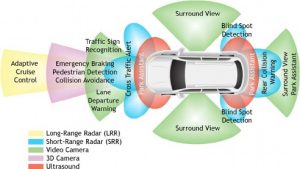
Cars (and trucks and SUV) also got heavier, which made them more wasteful of natural resources – and not just fuel. And they became much more expensive to insure, being more likely to crash and much more expensive to repair when they did.
That’s what all of this compliance in the name of “safety” has cost us. To say nothing of the aesthetic cost of uglified, homogenous cars that are almost all crossovers or SUVs now – and that all look pretty much the same, which is a consequence of the same factor that makes all NASCAR cars look the same. Both must conform to a template that makes it effectively impossible to make them look much different, one vs. another.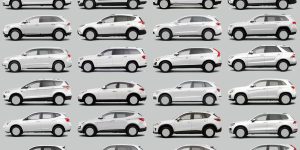
And it’s not just cars that are less likely to crash that government didn’t conjure into existence via its “safety” mandates (which ended up making them more apt to crash). Government also didn’t make cars use less gas.
That came about via such non-mandated design advances as the overdrive transmission.
These began to appear as standard equipment in Japanese cars back in the ’70s, which was part of what made them attractive to buy vs. American cars that didn’t have overdrive transmissions. Overdrive transmissions greatly reduce how fast the engine spins at highway speeds and that greatly increases fuel economy and reduces wear and tear on the engine.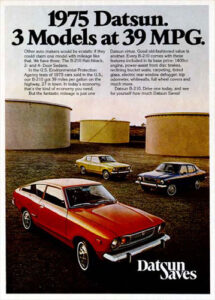
The advantages of overdrive transmissions quickly became obvious and – today – every vehicle has one.
Government had nothing to do with this, either.
But the government has succeeded in making the typical new vehicle less efficient, via the various “safety” mandates that have made the average new vehicle much heavier than the vehicles that were made before the government began ordering them to be “safer.” Even with overdrive transmissions – and port fuel-injected engines – the typical new vehicle is not especially fuel-efficient and many are less efficient than the cars that were available 40 years ago, before the government began making them “safer.”
That’s why you can’t buy a 50-plus MPG new car anymore – like you used to be able to do 40 years ago – unless you buy a hybrid car (the hybrid side compensates for the waste imposed by the weight) and it’s much harder to buy a new car that’s less likely to run into things because you didn’t see them.
But it’ll be “safer” for you if you do.
. . .
If you like what you’ve found here please consider supporting EPautos.
We depend on you to keep the wheels turning!
Our donate button is here.
If you prefer not to use PayPal, our mailing address is:
EPautos
721 Hummingbird Lane SE
Copper Hill, VA 24079
PS: Get an EPautos magnet or sticker or coaster in return for a $20 or more one-time donation or a $10 or more monthly recurring donation. (Please be sure to tell us you want a magnet or sticker or coaster – and also, provide an address, so we know where to mail the thing!)
If you like items like the Baaaaaa! baseball cap pictured below, you can find that and more at the EPautos store!



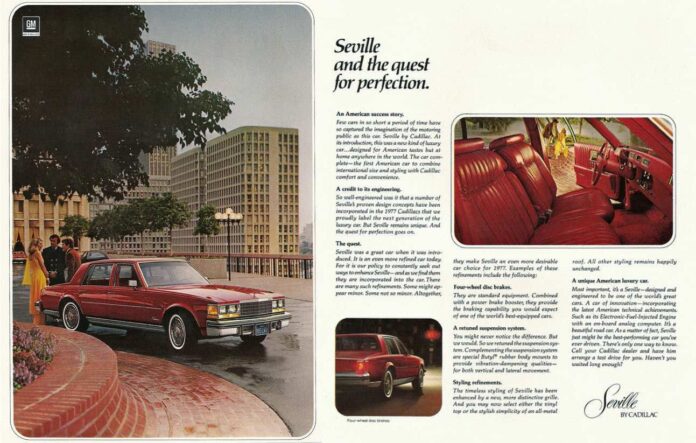








Safety…
Pushing people into 5000 lb EV’s with no brakes….they are so heavy they won’t stop and the brakes catch fire….this matches the battery which also can catch fire….the most usafe vehicle ever made…..
2024 Tesla Model 3 Performance on the Nürburgring….goes only one quarter of a lap and the brakes catch fire…..
goes only one quarter of a lap and the brakes catch fire…..so they slow down…but…the battery still overheats and gives less power….
drive an EV hard…the battery overheats and it cuts back power….total junk….
EV’s….they are so heavy they won’t stop and the brakes catch fire….but…100% of their marketing for EV’s is….floor it…and do 0 to 60 in 3 seconds….and crash into a tree…..
https://www.youtube.com/watch?v=0tdhYevUGwM
You guys may like this column……we used to have control of automobiles until auto manufacturers were MANDATED by government diktat to install all sorts of “Saaaaaaaaaaaafety” features, spyware, and Nanny state gadgets.
https://www.paulcraigroberts.org/2024/07/05/cars-i-remember-when-we-had-control-of-cars-today-we-obey-software-programs/
They showed us many fatal car crash videos in fire department training where the victims were totally smashed an impregnated into the steering column and the dash, as well as gross photos and videos of victims that were ejected and all kinds of other gross death stuff. All meant to gross you out and prepare you for horrible traffic collision incidents. I found all this strangely captivating and felt like I was part of the elite of fire/ems for being able to view this stuff. PS- It was also meant to weed out those who couldn’t handle it. Saw a lot of gruesome stuff in my career, and I would think “wow, look at that” and then you would have to continue on to get the job done. Glad I’m retired.
We had one guy that dropped out because he just couldn’t handle the blood.
OT: Crazy prices on Dodge/Ram/Jeep:
https://www.youtube.com/watch?v=rh4lhj33t9g
A $125K sticker price on a pickup? HA HA HA.
Those who can’t afford it just press their nose against the window in hope and envy. Need a side hustle selling meth or something.
Those who CAN afford it are sophisticated enough to walk away from a terrible deal on a depreciating asset.
This way to the egress, folks.
Why do we need seat belts when we have airbags? And what about school buses which have no seat belts and no airbags for the precious children? Just think if a busload of kids goes off the cliff, with no safety devices to save them, it would bad like Gaza kids being blowed up by USA bombs.
The argument the government cares about your safety is false when the same government gives bombs to blow up kids in UN schools in Gaza. Or that the government mandating air bags cares about you when they just killed 20 million from the death jab is just laughable and insane. A government 35 trillion in debt my just want you dead in a desperate attempt to achieve fiscal solvency.
Dead senior citizens = big social security savings per year.
And those UPS drivers, I see them jumping in and out of their vans and not put on that seat belt you must wear to be safe. The best of all is the garbage truck driver who stands in the doorway and operates the truck by remote control. He’s not even in the driver’s seat, nor is he even all the way in the truck!
What about those motorhomes you can walk around in while driving? Don’t be like that rich foreigner who came to Amerika and bought a motorhome thinking the cruise control was an autopilot. LOL
“In November 2000, Mr. Grazinski purchased a brand-new 32-foot Winnebago motorhome. On his first trip home, having joined the freeway, he set the cruise control at 70 mph and calmly left the driver’s seat to go into the back to make a cup of coffee.
“Not surprisingly, the Winnie left the freeway, crashed and overturned. Mr. Miliekowski sued Winnebago for not advising him in the handbook that he could not actually do this. He was awarded $1,750,000 plus a new Winnebago.”
And then you have a motorcycle, zooming along with no seat belt or air bags! Some genius invented the air bag motorcycle jacket. Good idea, just don’t tell the overprotective bureaucommiecrat..
The EeeVee Fallacy (continued):
Ford sold 7,902 F-150 Lightning electric trucks in 2Q 2024. Meanwhile, all F-series truck sales totaled 199,463 in the 2nd quarter.
Ford doesn’t break down F-series sales into F-150, F-250, F-350, etc. But F-150 sales typically run about 60 to 65% of total F-series sales. At the low-end 60% estimate, that would be 119,678 F-150s sold.
Now for a little EeeVee math: (7,902 Lightnings / 119,678 F-150s) = 6.6% electric
I have long claimed that no matter how hard he tries, Lightning Jim Farley never will succeed in pushing F-150 Lightning sales sustainably above 10% of all F-150 sales. And so far, despite one quirky quarter, the proposition holds.
Earth to Jim F: just give up, dude. YOU LOST.
Or, that “Limey” could have driven a surplus Valentine tank, which crossed the line at the time between a light tank versus a medium. They weren’t much for firepower or protection, but damn, they ran and wouldn’t quit! When the Valentine was obsolete as a battle tank (the British Army accepted the American M4 Shermans and even developed their own special tank hunter, the VC Firefly, with the powerful 17-pounder gun), the leftover ones were repurposed into a self-propelled artillery piece, the Bishop, carrying the useful 25-pounder field gun, a funky tank destroyer named the “Archer”, which had the 17-pounder in an open mount, facing BACKWARDS (the vehicle would back into a firing position, then drive forward to “run like bloody hell” before the Germans retaliated), and numerous command, combat engineering, and tank recovery vehicles. When the British Army wanted a light AFV for use by Airborne, bringing stored Valentines and Archers out of mothballs was seriously considered (‘they’d have been equipped with either a low-pressure 76 mm gun or a 30-mm rapid-fire autocannon), but ultimately, the Alvis Scorpion was picked.
A lot of the technology that makes cars safer…disc brakes, better suspensions, etc., came from race cars.
An automotive engineer said….all this fake safety crap like airbags, self driving technology, etc….have made driving less safe…drivers think they don’t have to be as vigilant….they can’t see out of these huge abortions anyways….might as well just text…and hope the self driving tech works…lol….
this self driving technology is very defective, doesn’t work….so it might kill you…..
The idea is that the lowering of the fatality rate and over the last 50 years has been due to improvements that mayerially improved cars steering, handling and braking that were outside the regulations imposed by the National Highway Traffic Safety administration. Many of them were invented in the 1950s and 60s. Europeans installed them first. The 1974 Arab oil embargo brought many european and japanese cars here with sway bars, racks, disc brakes, strut suspensions and iverdrive transmissions. All of these worked together to give the buyer a much better automobile. Ans a safer one. Strong leg mucles make up the ingredients of a safe automobile.
It showed up in the numbers. Fatality rates dropped precipitously through the 70s and especially the 80s despite a quiet regulatpry climate. In the 90s through today, the regulatory climate is much more activist beginning with Jerry Ralph Currys (bush 41 nhtsa secretary ) implementation of airbags rules and forays into the beginning of side impact regulation.
The post Reagan regulatory era has flatlined, primarily because the heavy lifting was done by the market demand for better suspensions, steering, braking and by noise reduction technology. A quiet car is far less denanding to operate at highway speeds than a noisy one.
Nothing in nhtsa regs addresses any of these concerns, including noise levels.
Todays environment is marked by cars that have terrible outward visibility. This is increasing the level of danger to all, driver and non driver alike.
I hope that someine has the balls to import a non harmonized car to the states and see how it sells
What strikes me is that during the 1950s, 60s and 70s, many imported cars had disc brakes, radial tires, front and rear sway bars, and independent suspension all around, along with overdrive transmissions and fuel injection—and they were cheaper than most of what the Big 3 sold.
Why the Big 3 didn’t adopt these both defies logic and makes sense at the same time.
It defies logic because people clearly wanted those things and were willing to pay more for them, and they needed to compete with each other and the rest of the world.
It makes perfect sense because a bean counter mentality was deep and endemic at the Big 3, and nobody complained too loudly, so why bother? And besides, only serious gearheads wanted that stuff, not Joe Six Pack who buys most of the cars.
As I’ve mentioned before, there are economic products and services produced to satisfy the law of supply and demand, and political products produced to satisfy political interests. Trouble is, the political products in the car industry clearly outnumber the economic products.
Those late 70s GM cars shared many running gear and suspension parts. My 79 Gran Prix was a base model no suspension upgrades.
So, off to the junkyard where I pulled a rear sway bar with the fittings and bolts off a 78 Monte Carlo. My Pontiac’s rear suspension arms already had the holes all I did was bolt on that salvage sway bar. Added gas shocks and Goodyear Eagle 70 series radials what a difference!
Also the brakes, again those era cars with power assist and front disks were great. Big thick rotors with the cooling channels cast in the middle. Add some Bendix Titanium pads perfect pedal “feel” and great stopping power. No computer in the link between your foot and the brake caliper.
That’s because, by then, the Gran Prix and the Monte Carlo were the SAME vehicle. Probably even had the same engine, although after an initial controversy in the late 70s, GM did try to make sure that Pontiacs could generally have a PONTIAC V8 (usually the 301) and Chevys came with the time-honored SBC V8, usually a 267, 305, or in the largest cars and full-sized pickups, a 350. Only the front clip, rear trim, and interiors offered differed, as well as the badging. And computers were BEGINNING to be used, typically with the engine emissions control. I believe it was in the mid-80s that Detroit started making OD Automatics standard, along with rudimentary (by today’s standards) control modules.
I remember. Gm started with overdrive transmissions in big numbers beginning around 81 or so. It started on the large cars.
Its I rinic that OD transmissions were brought onto the narket when the speed limit was still 55. Even older vehicles sounded quiet at 55 mph.
They could put a “lower” gear ratio into the final drive, which made it easier on the engine at low speeds, that also gave the vehicle some “pep” with an otherwise “wheezy” engine…keep in mind that the 301 Pontiac, in the late 70s and early 80s, with a Rochester 2GV carb, put out a measly 125 ponies, NET. An OD was the only way to keep the engine from turning too high revs at “55”, or more like 70 which most people drove when they saw no cops on the freeway.
Exactly. The numerical ratios started to rise after the advent of overdrive. The Cadillac Seville featured in Erics article had 2.56 gearing. I could imagine you could go with 3.08 or 3.27 after going to overdrive.
On the highway, thw Seville was quiet, but had zilch around town
Oh yea, my beloved “Old Yeller” (stock paint that late 70s poupon yellow) had the 301 Pontiac V8 and that pinnacle of lame engineering, the Turbo 200 metric 3 speed auto trans. Fortunately for me the trans was rebuilt before I bought it in 84, they upgraded the guts and it had a shift kit too. It was supposed to be my short term car till I found something better, than never happened and 21 years later it finally gave up the ghost when the trans puked fluid on the 20 mile drive home from work, just made it into the driveway.
The pearl clutching old biddies at “The Consumer Magazine “ listed it as a “don’t buy” in 84, what a bunch of morons. Best $3500 I ever spent. No major repairs in 21 years. Couple water pumps, fuel pump, radiator, batteries, the usual stuff. Yep, here you go, mine looked exactly like this one. Notice the big glass, narrow A pillars, mirrors down low on the doors = great visibility.
https://gbodyforum.com/threads/1979-pontiac-grand-prix-lorigprix.84916/
Can’t log crashes that don’t happen.
When you leave the house on any day, there is no guarantee you’ll be back at home at the end of the day. You have to take your chances to get anywhere in this world. You might make a mistake or two along the way, you keep on doing what is right.
Mistakes cost money you won’t get back.
As long as you pay through the nose to be safe at all times, all is well. If you don’t pay through the nose, eventually you will. It is safer, something could happen to you, you know.
You have to be careful when you are driving a tractor, you could fall off the thing and the rear tire with wheel weights will run you over. It’ll be bad, so you do everything required to stay put on the tractor seat and keep on plowing.
No seat belt, no cab, no airbags, it is dangerous, somebody could get hurt. If I want lots of vegetables and sweet corn, you have to live dangerously at times, otherwise, life can be quite dull.
Can’t stand on one leg and hold your breath all of the time, just doesn’t work like that.
Have a great little planting of carrots, which are sometimes hard to grow, got lucky this year.
Amazingly, after over 50 years since their introductions, the Automotive Illiterates in the US Government have not mandated rear amber turn signals or rear fog lights.
The last thing we need are more mandates. People are not so illiterate they don’t know what a flashing right or left red tail light means.
You have entirely missed the point of the article.
And to this day nearly 50% of motoring fatalities come from people not fastening a seat belt. Now that is illiterate.
The latest and greatest new safety “regulation”. All of us are required to stay in bed, except for eating and using the restroom. And they are working on those two as well.
I’m sure pharma can help.
‘The advantages of overdrive transmissions quickly became obvious and – today – every vehicle has one.’ — eric
Overdrive was an option on some US-made vehicles in the 1960s.
I rode in a late 1960s Chevrolet Impala with three-on-the-tree and overdrive — which was not a fourth gear on the steering column, but rather a push-button, electromechanically-activated unit. This led to misunderstandings.
The church lady in the drivers seat activated overdrive, with a great lurch, to PASS on a two-lane highway. It took forever to get around. Then at cruising speed she deactivated it, with another lurch. All present were underwhelmed by overdrive: it definitely didn’t offer blazing acceleration. ‘Won’t do THAT again,’ she grumbled.
Just wanted to get this anecdote out there before president Kamala takes over … and casting aspersions on female drivers might subject me to arrest and DEI re-education.
In the early 70s high school years my buddy fixed up and drove for several years, a 1950 Ford with flat head V8, 3 on the tree, and an electric activated overdrive. Worked just dandy, but the expectation was the driver understood how a vehicle worked – what a concept!
That OD add on was around a long time.
It was not properly marketed and probably suppressed. Carmakers often feltbthat car accidents were caused by speeding and bad driving, not by their defective products. Overdrive made relaxed highway cruising much easier. I dunno
Been around since the 1930s. No conspiracy involved.
I had an overdrive on a ’68 Rambler that I owned for a few years when I was a teen. Car had “Three on the Tree”, the O/D was activated by pulling out a “Tee” handle, akin to a parking brake (and it had the Tee-Handle parking brake also, so you had to take care as to which was which), and tapping the gas pedal; the planetary gears would then kick in, and you’d feel that AMC Six drop in RPMs. It wouldn’t activate above 50 mph, and, of course, you could only do it in “Third”. I believe that was a dealer-installed option. One time, just to see the “numbers”, I got some 6 ft leads with alligator clips, and hooked up the tach/dwell meter, and drove and watched the tach, at 60 mph, the engine dropped from about 3500 RPM to about 2400! Needless to say, that underpowered Rambler (engine was “bulletproof”) with that wheezy Holley 1920 single-barrel could still cruise effortlessly at 75 mph, not bad for a staid “econobox”! Back when “I can’t drive…Fifty-Five!”, that was about as fast as one DARED, unless get jailed for “reckless speeding” was your thing.
The point is, the tech was SIMPLE to understand and control, and I had ever had to, if something went wrong, I probably could have gotten some snap-ring pliers and gear pullers, followed instructions, and rebuilt it if I had to. Today’s engines and/or transaxles? Even the pros don’t touch ’em, just replace with a used engine or “tranny”, or an expensive rebuilt. Fortunately, if you’ve taken care of it, that drivetrain shouldn’t give out until fairly much the rest of the vehicle is worn-out anyway.
Thats the thing. People might change their oil, but they forget about the transmission. Thats ehy most powertrains give up.
The ultimate driver safety goal of the feds is to not allow people (everyone but the elitists) to drive at all. Everything from “climate change”, “protecting children”, diminishing wages, excessive taxes, etc. are putting the squeeze on mobility.
Government has used “Saaaaaaaaaaaaaaafety” to justify all sorts of insane things over the past I don’t know how many years. They even used it as justification for all the draconian COVID measures (lockdowns, face diaper & COVID vaxx mandates, vaccine passports, etc.) we were forced to endure that (at that time) seemed would never end. Will government also use “Saaaaaaaaaaaaaaaaaaaaafety” as justification for draconian climate change measures, censorship, WWIII, CBDCs, and even bird flu hysteria?
There was a time when car advertising spoke of their “5 star safety rating” from NHSTA. It was a selling point. Here’s the 2024 numbers:
https://www.nhtsa.gov/press-releases/nhtsa-2024-crash-test-vehicles-5-star-safety-ratings
Notice anything? The best selling vehicle in the US, the Ford F-150, isn’t on the list. I guess safety doesn’t sell like it used to.
But then again, there’s probably a reason why the F-150 isn’t “earning” a 5 star rating. I’m fairly certain someone at Ford looked at the test, maybe even mocked up their own test stand and ran a few prototypes down the chute to see how they did. Then determined it wouldn’t be worth the radical changes needed to get it into compliance. Walk up to any F-150 in a parking lot and push on the fender. It will easily flex and distort, but no need to worry about the owner getting upset because it will pop right back into shape. Because it’s thin plastic. Weight savings (CAFE) is more important than crash testing.
But what about the cars that do “earn” the 5 star rating? Well, they’re built to pass the test. VW got into hot water over their “build to the test” scandal, and it looks like GM might be in the same boat now too. But CAFE and crash tests are different animals -you can’t reprogram sheet metal to behave differently when on a test sled. But the manufacturer is very much aware of how the tests are performed and will make sure to bolster up the areas where the impact machine will hit. Designing for the test, just like the VW scandal.
Better hope that when you’re T-boned in the intersection that the other driver aims for that sweet spot too!
In case you missed it: GM fined for emissions violations of older vehicles.
https://www.zerohedge.com/markets/gm-pay-146-million-penalties-emission-violations-59-million-older-vehicles
$146 million? Where’s the forced buybacks? The court trials? The engineer perp walks? I’m sure many of those poor GM owners had no idea their vehicle was emitting more than their fair share of emissions. How dare they!
And $146 million is not all. After GM was forced to forfeit regulatory credits used for CAFE compliance, it estimated the total cost of settling with EPA at $490 million. Any resemblance to bribing a Mexican cop with una mordida is totally unintended.
You know that you’re living in a crazy world when government requirements result in two ton economy cars that you can’t see out of, get less fuel economy than in the past, are less reliable than 20 years ago and are a lot more expensive to repair.
I’m curious if the Chevron ruling will make a difference or not but either way I find it unlikely that the bureaurats will give up their power.
I’m not holding out hope that the Chevron decision will make a difference. Bureaucrats won’t give up their power. But neither will the auto manufacturers since the said bureaucrats stifle competition on their behalf.
From this week’s “Thoughts From the Frontline,” John Mauldin’s weekly newsletter:
Let me propose something radical. If we actually want Congress to pass the laws needed for a functional bureaucracy, then we need to expand congressional staffs. Dramatically.
https://www.mauldineconomics.com/frontlinethoughts/meditations-on-independence#founders
I think in the short term this will probably lead to a much larger bureaucracy, boosting up congressional staffers and federal judges. Many of the new people will be swamp creatures, all bucking for the plum staff seats in the house and senate leadership positions. The judges will need advisors too, along with a whole new cavalcade of prosecutors. They too will likely come from the executive branch at first, and because of that the outcomes will be the same as before, but over time the rules will change and maybe even lead to the will of the people (FWIW).
Mauldin included an excellent essay on Chevron deference by Rod Martin:
‘Chevron implicitly eliminated your Seventh Amendment right to a jury trial, by largely eliminating your right to appeal an administrative law judge’s ruling to an actual, constitutionally-authorized Article III court.
‘Bureaucrats argue … that the subject matter addressed by agencies is so complex, so intricate, so specialized that not only can a jury not understand, neither can an Article III federal court.
‘Chevron replaced “government by the people” with that priesthood of experts, those who must simply be trusted to be benevolent, all-knowing, and true. This is the technocrat’s and socialist’s (but I repeat myself) dream: to eliminate the great unwashed from the process of scientific government.’
Great stuff. Whereas Mauldin’s proposal to augment Congressional staffs — so that THEY can become a priesthood of experts — nullifies everything Martin wrote.
I read that article too, great essay but as you mentioned John Mauldin still believes we need regulatory agencies, just a little lighter touch. That will never happen since every govco agency everywhere is only interested in growing in size and power.
Mauldin fails to comprehend the duty of the retailer to vet suppliers, retail reputation and choice is a powerful regulator. And the possibility of firms like Underwriters’ Labs and Good Housekeeping and The Consumer’s Union who are independent test firms that offer their services to make sure products are “safe and effective”
As long as there are choices. For example, I know that CU isn’t all they claim to be, but some people swear by their reviews. If the .gov wasn’t crowding out the competition there’d likely be many such firms.
70’s Flashback
MG ran a tv ad that “highlighted” their 5mph bumper. It showed a wall in profile and an MG rolling at 5mph toward it, also in profile. At the “moment of impact” the MG rolled behind the wall while the british announcer dryly declared, “In England we try to miss the wall”
Welcome to GovCo, screwing things up since the dawn of time.